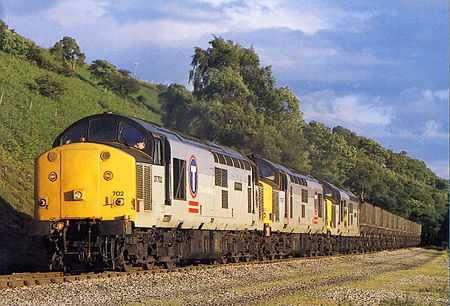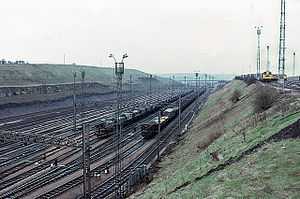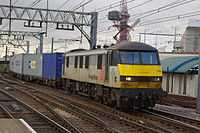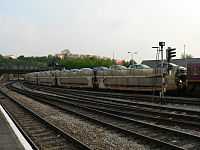Rail freight in Great Britain

The railway network in Great Britain has been used to transport goods of various types and in varying volumes since the early 19th century. Goods traffic is currently low compared to historic levels, but growing. Network Rail, who own and maintain the network, aim to further increase the amount of goods carried by rail.[1] In 2013-14 Britain's railways carried record amounts of goods on its network, with 22.7 billion net tonne kilometres moved, a 5.8% rise compared to 2012-13.[2] Coal accounted for 35.0% of goods transport in Britain. There is no goods transport by railway in Northern Ireland.[3]
History
.jpg)
19th century
Many of the early railways of Britain carried goods, including the Stockton and Darlington Railway and the Liverpool and Manchester Railway. The LMR was originally intended to carry goods[4] between the Port of Liverpool and east Lancashire, although it subsequently developed as mixed passenger-goods railway.
Early 20th century
The First World War was dubbed the "Railway War" at the time.[5] Indeed, thousands of tonnes of munitions and supplies were distributed from all over Great Britain to ports in the South East of England for shipping to France and the Front Line. Due to pre-war inefficiencies in the rail goods transport, a number of economisation programmes were needed to allow the railways to meet with the huge demand that was being put on their services. The Common User Agreement for wagon usage and regulation of coal services through the Coal Transport Act of 1917 are examples of such programmes, which enabled better utilisation of railway assests across the industry. The success of such schemes was entirely down to the collaboration of more than 100 railway companies, who abandoned the fierce competition of the pre-war years to work together in the national interest. In no sector was this more obvious than in rail goods transport.
During the Second World War, vast quantities of materials were moved around Britain by rail. During the early stages of the war, goods trains ran to rural stations in Norfolk to enable airfields to be constructed.[4] In 1944, 500 special trains ran every day on the network and over a million wagons were controlled by the government's Inter-Company Freight Rolling Stock Control organisation.

Beer was a major rail-hauled commodity, but gradually switched to the improving road network. The complex network of brewery railways in Burton-Upon-Trent became disused by 1970. Milk was widely transported by rail until the late 1960s. The last Milk Tank Wagons ran in 1981.
Nationalisation era
Britain's railways were nationalised in 1947 including goods operations. Under the 1954 British Rail Modernisation Plan, massive investment was made in marshalling yards at a time when the small wagonload traffic with which they dealt with was in steep decline, and being lost rapidly to the roads. The Beeching cuts included a reduction in freight services, and the modernisation of coal and heavy mineral traffic.[4]

In the 1980s, British Rail was reorganised into "sectors" including four goods sectors:
- Trainload Freight took trainload goods
- Railfreight Distribution took non-trainload goods
- Freightliner took intermodal traffic
- Rail Express Systems took parcel traffic
In 1986, quarrying company Foster Yeoman prompted a turnaround in the reliability of rail freight by obtaining permission to run its own locomotives, and importing the first 4 EMD class 59s. This design was developed into the class 66 which became widely used by EWS and other operators over a decade later.
Privatisation era
The opening of the Channel Tunnel in 1994 allowed direct goods trains to run between the UK and the continent for the first time, although there were issues with refugees at the Sangatte camp attempting to use the trains to enter the UK.[6]
British Rail was privatised in the 1990s. Six freight operating companies (FOCs) were set up:
- Trainload goods was split into three geographical units (all were purchased by Wisconsin Central and amalgamated into EWS in 1996[4]):
- Mainline Freight in the south-east
- Load-Haul in the north-east
- Trans-Rail in the west
- Railfreight Distribution was also sold to EWS in 1997
- Rail Express Systems was also sold to EWS in 1996
- Freightliner was privatised as Freightliner
Subsequently, EWS' nuclear flask train operations were sold to the new company Direct Rail Services set up by British Nuclear Fuels Limited.
GB Railfreight was a new freight company established in 1998 by GB Railways.
Since 1995 the amount of goods carried on the railways has increased sharply due to increased reliability an economy. The railways have become more reliable, and economical. increasing by 65% between 1995/96 and 2006/07.[7] Major road haulage operations such as Eddie Stobart LTD and WH Malcolm move goods by rail, hauling supplies from Asda and Tesco. Morrisons also use rail freight, as do M&S and many more retailers. By the year 2015 rail-borne intermodal traffic is scheduled to double, and by 2030 the whole of rail freight is expected to double.
The Rail Delivery Group set up by the DfT includes representatives of rail freight companies.[8]
Current operations
Goods carried by rail are either intermodal (container) freight or trainload freight which includes coal, metals, oil, and construction materials.
There are four main freight rail operating companies in the UK, the largest of which is DB Schenker (formerly EWS). There are also several smaller independent operators including Mendip Rail.
Intermodal freight

A "liner train", or "freightliner", is a UK term for a train carrying intermodal containers.[9] The name was coined by Richard Beeching in the 1960s, and later became the Freightliner sector of British Rail. This was sold off as a private enterprise, Freightliner, in 1995, as part of the privatisation of BR. "Freightliner" or "liner" may mean either intermodal services run solely by Freightliner, or intermodal services in general.
Additionally, a "bin liner" or "binliner" is a slang term for a liner train carrying containers of waste for disposal.[10]
Terminals

Major intermodal freight terminals include:
Sea ports
- Felixstowe (GB Railfreight)
- Seaforth Dock, Liverpool
- Southampton
- Thamesport
- Tilbury
Inland terminals
- Birch Coppice near Tamworth, West Midlands
- Daventry International Rail Freight Terminal, West Midlands
- Dollands Moor, Kent - for freight via the Channel Tunnel
- Telford International Railfreight Park
- Trafford Park Euroterminal
- Wakefield Europort
- Wembley European Freight Operations Centre
Trainload freight

Trainload freight movements include:
Coal
- DB Schenker Rail (UK) run coal trains between mining sites in South Wales, Nottinghamshire, South Yorkshire and Scotland and coal-fired power stations around Britain.[11] These are run using merry-go-round trains.
- 40 coal trains per day run from Immingham to coal-fired power stations in the Aire Valley (Drax, Eggborough, Ferrybridge) and the Trent Valley (Cottam, Ratcliffe-on-Soar, Rugeley, West Burton).[12]
Construction materials
Food and drink
- Asda grocery goods movements between distribution centres in Daventry, Grangemouth and Aberdeen[14]
- Tesco movements operated by Stobart Rail from Daventry to Mossend and Inverness.
Nuclear flask trains
All nuclear flask trains are operated by Direct Rail Services.
Steel
- Tata move steel products from Margam to Llanwern by rail,[7] and from Scunthorpe to Ebange (France) via the Channel Tunnel. 10 trains run to/from the major Tata plant at Scunthorpe.[12]
Timber
Timber trains currently run from Chirk to Cumbria, Baglan Bay in South Wales and Teigngrace in Devon.[15]
Vehicles
Road vehicles, particularly passenger cars, can be moved by rail using autoracks. Ford and Honda are two companies who use rail to transport road vehicles. Jaguar Land Rover and BMW also use rail to transport vehicles.

Waste
"Binliner" routes include:
- Northolt and Cricklewood to Calvert landfill site
- Routes from Greater Manchester to Roxby Gullet landfill site (Freightliner)[16]
References
- ↑ "Freight opportunities". Network Rail. Retrieved 23 May 2013.
- ↑ Office of Rail Regulation, http://orr.gov.uk/news-and-media/email-alerts/2014/orr-data-shows-continued-growth-in-freight-usage
- ↑ "How the Rail Freight industry works". Mode Shift Centre. Retrieved 23 May 2013.
- ↑ 4.0 4.1 4.2 4.3 Wolmar, Christian (2007). Fire and Steam. Atlantic Books. ISBN 9781843546290.
- ↑ Pratt, Edwin A (1921). British Railways and the Great War Book. London: Selwyn and Blount, Ltd. ISBN 1151852406.
- ↑ "Closing Sangatte 'not enough'". BBC News. 23 May 2002. Retrieved 23 May 2013.
- ↑ 7.0 7.1 Network Rail - Value and Importance of Rail Freight, July 2010
- ↑ "Rail industry needs clarity on contracts and public support". The Guardian. 24 October 2012. Retrieved 23 May 2013.
- ↑
- ↑ "CL2 60094 on Calvert bin liner Train,High Wycombe :: 60094.jpg :: Fotopic.Net". Andrew46.fotopic.net. 24 October 2008. Retrieved 1 February 2010.
- ↑ Young, David. "Energy Business Segment".
- ↑ 12.0 12.1 "Update on rail repair". Hatfield & Stainforth. NetworkRail News. 17 May 2013. Retrieved 23 May 2013.
- ↑ "wins rail freight 'Oscar' for Northfleet reconnection project". Lafarge. 27 September 2012. Retrieved 23 May 2013.
- ↑ "Asda - Rail Freight". Institute of Grocery Distribution. Retrieved 23 May 2013.
- ↑ "Traffic". Railfan's Traffic Guide. North Wales Coast Railway. 11 February 2013. Retrieved 23 May 2013.
- ↑ Hall, Brian (12 July 2011). "Imaging Centre :: 66545 at Roxby Landfill site". Railway Herald. Retrieved 23 May 2013.
External links
| Wikimedia Commons has media related to Freight trains in the United Kingdom. |
| ||||||||||||||||||||||||||||
